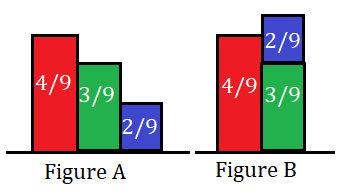Agent Smith
Full Member
- Joined
- Oct 18, 2023
- Messages
- 340
A bag contains 4 red balls, 3 green balls, and 2 blue balls. You pick a random ball.
P(ball is red) = P(R) = 4/9
P(ball is green) = P(G) = 3/9
P(ball is blue) = P(B) = 2/9
P(ball is not red) = P(~R) = 3/9 + 2/9 = 5/9
What is the probable color of the random ball you picked?
1. P(~R) > P(R). So the ball is probably not red i.e. it's probably green or blue.
2. P(R) > P(G) and P(R) > P(B). So the ball is probably red than green and also it's probably red than blue.
Are the 2 conclusions above (1 and 2) in conflict? 1 is saying the ball's probably not red and 2 is saying it probably is red.
P(ball is red) = P(R) = 4/9
P(ball is green) = P(G) = 3/9
P(ball is blue) = P(B) = 2/9
P(ball is not red) = P(~R) = 3/9 + 2/9 = 5/9
What is the probable color of the random ball you picked?
1. P(~R) > P(R). So the ball is probably not red i.e. it's probably green or blue.
2. P(R) > P(G) and P(R) > P(B). So the ball is probably red than green and also it's probably red than blue.
Are the 2 conclusions above (1 and 2) in conflict? 1 is saying the ball's probably not red and 2 is saying it probably is red.



